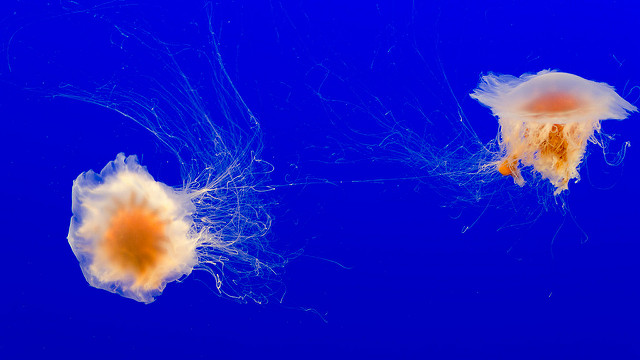The lovely and absorbing new book Spineless: The Science of Jellyfish and the Art of Growing a Backbone, began when author Juli Berwald, a marine scientist turned technical writer, was factchecking an article about ocean acidification for National Geographic. She was asked to confirm a seemingly simple claim, made in a graphic, that jellyfish would be among the “winners” in an acidifying ocean. Berwald found herself in a sea of intriguing unknowns, and she eventually embarked on a years-long jellyfish odyssey that took her to Japan, Israel, and elsewhere.
This past weekend, her book tour brought her to Powells Books in Portland, Oregon, where we had a chance to talk about what she’s learned about jellyfish—and how much remains unknown.
So why a book about jellyfish?
When I dug into the scientific literature, I found that the science about jellyfish and ocean acidification certainly wasn’t settled. I also found this really dynamic debate about what’s happening with jellyfish in our damaged oceans: How are our oceans affecting jellyfish, and what are they telling us about what we’re doing to the seas? Those were the scientific questions I couldn’t let go of.
Jellyfish are also an amazing muse, because they live in this fascinating space between angelic and demonic. They’re gorgeous, and yet some of them are lethal. You can follow them back and forth from hero to antihero, but you can’t pin them down, and for a writer, that’s really magical.
You write that even the words we have for jellyfish are both angelic and demonic.
Totally—in Spanish they’re called “living water,” “bad water,” “curdled water,” and even “tears of the sea.” In Chinese, they’re called “sea bugs,” and in Turkish they’re called “brides of the sea.” Jellyfish are envisioned in so many ways in so many different cultures, and for good reason—they are all of these things. They’re not a black-and-white kind of creature.
The English word for them speaks to their paradoxical nature, too — how can a fish be made out of jelly?
Exactly, and a lot of people have asked, “Should we keep calling them jellyfish? Should we call them sea jellies instead?” We could, but no one will know what we’re talking about.
The “jelly” part of jellyfish is extremely important to them—their spinelessness is why they’re successful, and will be successful in the ocean. Because the jelly is acellular, they have very low metabolism relative to their mass, and because it’s incompressible, like water, they only have to use their muscles to squeeze their bell, and the water inside does the act of releasing for them. And it allows them to be transparent.
I think a lot of us have seen the dramatic headlines you talk about in your book — “Meet Your New Jellyfish Overlords,” “Sea of Slime,” that sort of thing. If that’s not the future, what does the future look like?
I think the question is way more local than global. From here on land, we tend to think about “the ocean,” but the ocean is obviously a hugely complicated and dynamic and diverse place. There are these hotspots where jellyfish have taken over ecosystems, and we should look to those places as warning signals, as illustrations of what can happen if we don’t pay attention. Those places tend to be places we’ve damaged enormously—damaged with pollution, with overdevelopment, with massive overfishing. Namibia, for example, used to have one of the richest fisheries in the world, but because of rampant overfishing coupled with a warming period, the fishery off the Namibian coast now has two to three times more jellyfish biomass as fish biomass.
In the Mediterranean, the effects of overfishing and development on the food web are more complicated, and they’re coupled with an invasive species problem. When I started out, I thought I could write chapters about jellyfish and overfishing, jellyfish and acidification, jellyfish and overdevelopment, and jellyfish and warming, but it was impossible. These things couple up, and triple up, in different environments.
The other problem is that we just don’t have good long-term data on jellyfish. For the whole 20th century, we’ve biased ourselves against jellyfish by studying the ocean with nets and winches, things that destroy jellyfish. We created a systematic bias toward durable things, so our baselines are very unclear.
The title of your book is Spineless, but the subtitle is “The Art of Growing a Backbone.” What can jellyfish teach us about growing a backbone?
Scientists are often unable to, or discouraged from, speaking their knowledge—especially in political situations, because a lot of their money comes from the government. But I learned that as a writer, and as someone who’s gathered a ton of information about something, no one’s stopping me from talking to my Congresspeople. I learned that I need to use my voice.
I wrote an op-ed in the New York Times about the doubling of the size of the Suez Canal—there were four treaties that should have controlled the invasive-species impacts of that project, that should have at least triggered environmental impact assessments, and none of them did. All of the treaties were violated. I spent two weeks calling all of the agencies involved, and they all hung up on me. When I started this project, I never imagined I would write an op-ed like that, but when you find out something important, staying quiet is a spineless thing to do. I learned to say, “You know, I know this stuff now, and I have to talk about it.”
The charming pair of fried-egg jellyfish (Phacellophora camtschatica) above was photographed at the Monterey Bay Aquarium by Flickr user Sean. Creative Commons.

I’m glad to live in a world where the two of you are talking to each other, and sharing it for all to see! (The jellies are cool, too.)